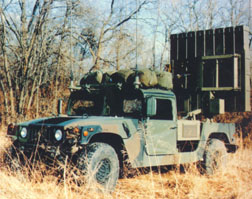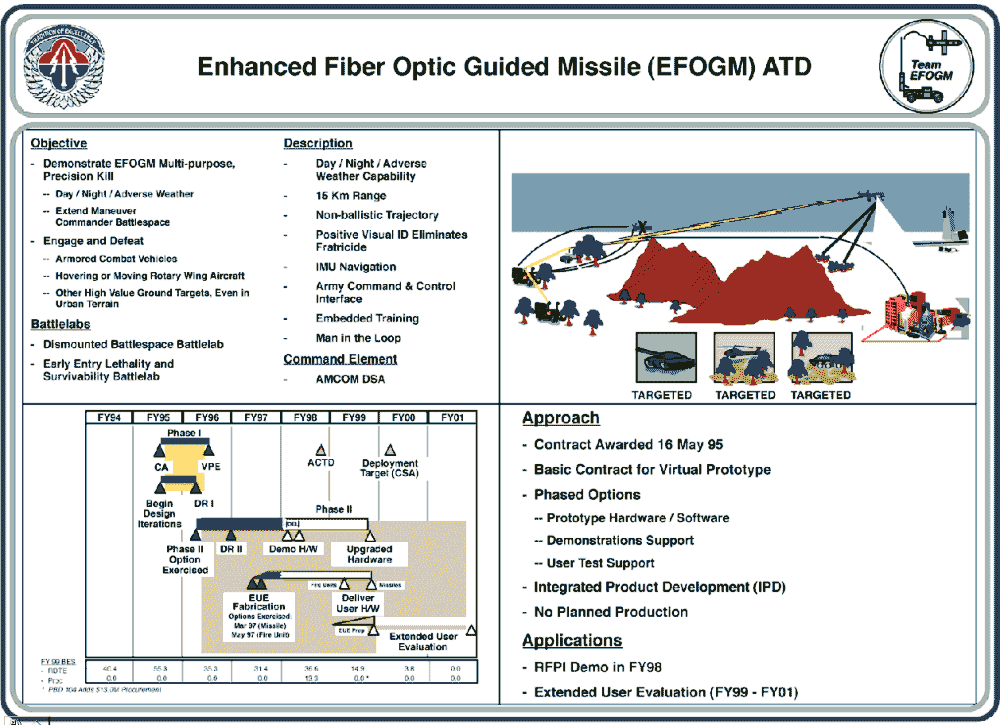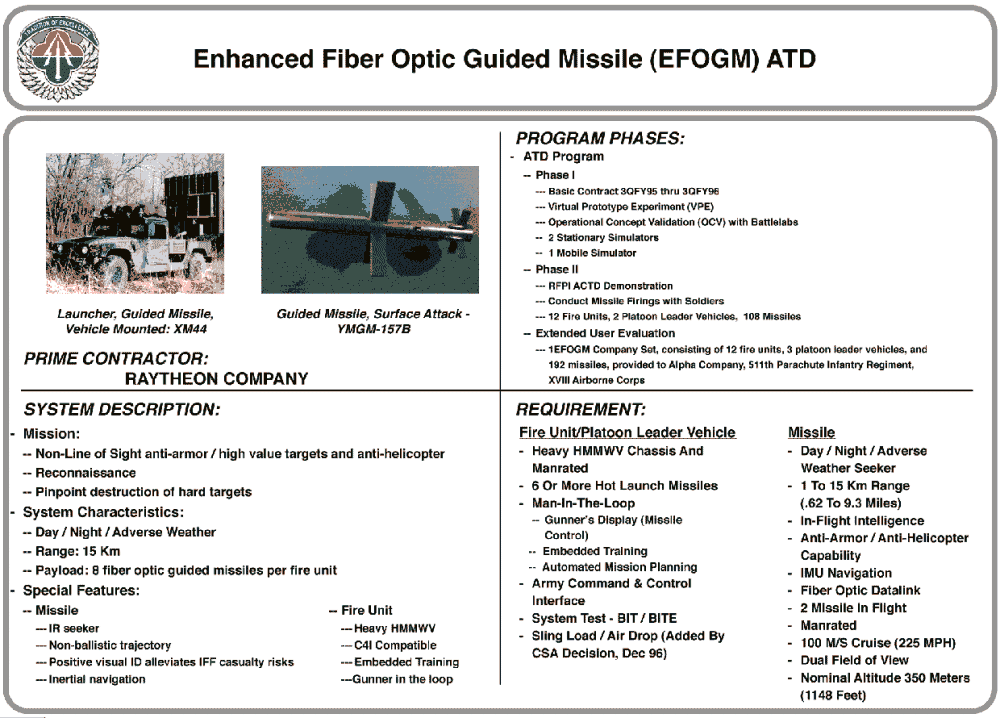 EFOG-M is a rapidly deployable missile system capable of defeating armored
vehicles, rotary wing aircraft and other high value targets. As part of the Rapid
Force Projection Initiative (RFPI), an ACTD "system of systems" composed of
hunters and killers, EFOGM will have real-time connectivity to hunters (forward
sensors), will be responsive via Force XXI C3I digitization, and will support JV 2010.
The EFOGM system consists of a fire unit and tactical missile with a fiber optic data
link. The 8-missile launch system is mounted on a High Mobility Multi-Purpose
Wheeled Vehicle (HMMWV), heavy variant.
The fire unit has four main components: HMMWV, gunner's station, launcher
assembly, and equipment bay. The gunner's station is located on the passenger side
of the HMMWV, and contains the missile launch controls, seeker video monitor, and
battle command computer display. The equipment bay houses the ground electronics
unit, video processing unit, power distribution unit, battle command computer, and
system computer unit.
The missile is a terminal homing missile that utilizes a fiber optic data link to transmit
and receive command and sensor inputs to find and defeat threat targets masked
behind hills, in foliage, or in urban settings. The missile has a high resolution infrared
video camera in the nose to provide the gunner with an unobstructed view of the
surrounding terrain from the missile's perspective. Once launched, the missile utilizes
inertial instruments to automatically navigate along a preprogrammed flight path up to
15 kilometers in length. The gunner can pan the missile's seeker to investigate targets
of opportunity as the missile flies a non-ballistic flight path around or over obstructing
terrain to pre-selected target areas. The gunner identifies and designates targets and
assists in refining the missile's aimpoint on vulnerable locations of the target.
EFOG-M enhances the Army's ability to dominate the ground maneuver battle
through its tactical precision engagement capability.
EFOG-M is a rapidly deployable missile system capable of defeating armored
vehicles, rotary wing aircraft and other high value targets. As part of the Rapid
Force Projection Initiative (RFPI), an ACTD "system of systems" composed of
hunters and killers, EFOGM will have real-time connectivity to hunters (forward
sensors), will be responsive via Force XXI C3I digitization, and will support JV 2010.
The EFOGM system consists of a fire unit and tactical missile with a fiber optic data
link. The 8-missile launch system is mounted on a High Mobility Multi-Purpose
Wheeled Vehicle (HMMWV), heavy variant.
The fire unit has four main components: HMMWV, gunner's station, launcher
assembly, and equipment bay. The gunner's station is located on the passenger side
of the HMMWV, and contains the missile launch controls, seeker video monitor, and
battle command computer display. The equipment bay houses the ground electronics
unit, video processing unit, power distribution unit, battle command computer, and
system computer unit.
The missile is a terminal homing missile that utilizes a fiber optic data link to transmit
and receive command and sensor inputs to find and defeat threat targets masked
behind hills, in foliage, or in urban settings. The missile has a high resolution infrared
video camera in the nose to provide the gunner with an unobstructed view of the
surrounding terrain from the missile's perspective. Once launched, the missile utilizes
inertial instruments to automatically navigate along a preprogrammed flight path up to
15 kilometers in length. The gunner can pan the missile's seeker to investigate targets
of opportunity as the missile flies a non-ballistic flight path around or over obstructing
terrain to pre-selected target areas. The gunner identifies and designates targets and
assists in refining the missile's aimpoint on vulnerable locations of the target.
EFOG-M enhances the Army's ability to dominate the ground maneuver battle
through its tactical precision engagement capability.
In 1994 the Under Secretary of Defense for Acquisition and Technology (USD(A&T)) proposed an advanced concept technology demonstration (ACTD) of the fiber-optic guided missile (FOG-M) technology. The Army has made two previous attempts to develop and field a combat system based on the FOG-M technology. Each time the Army has failed, due to a combination of technology, cost, and operational concept problems. It is still unclear which combat arm should operate a fiber-optic guided missile and for what missions. Other concerns include target identification and acquisition, rate of fire, fire control, range, organization, and additional force structure requirements. Previously prepared organization and operational concepts documents have failed to adequately address these issues. Cost has also been a major concern. The last Army effort was terminated when the cost of a single missile exceeded $400,000. This ACTD, unlike previous technology demonstrations, is designed to produce usable hardware even if the concept does not prove worthy of a large follow-on acquisition program. Even so, the cost of residual missiles and fire units will be extremely high (missiles and individual fire units may cost up to $500,000 each), and cost growth from initial projections is an all-too frequent occurrence.
The EFOGM Program, a critical component of the RFPI ACTD, is an Advanced Technology Demonstration (ATD) and as such does not have a TEMP. Phase I of the ATD featured an Early Soldier Evaluation held in August 1995 at Fort Benning, designed to evaluate system ergonomics, safety, reload, stowage accessibility and to recommend design modifications. In June 1996, a Battle Lab Warfighting Experiment was conducted at Fort Benning, consisting of the Virtual Prototype Experiment (VPE) and the Operational Concept Validation (OCV). The VPE confirmed that mobile and stationary Phase I simulators replicate capabilities outlined in the ATD Plan, Phase I exit criteria. The VPE consisted of:- Captive flight testing at Redstone Arsenal
- Simulated mission engagements at Fort Benning
- Missile reload operations at Fort Benning




